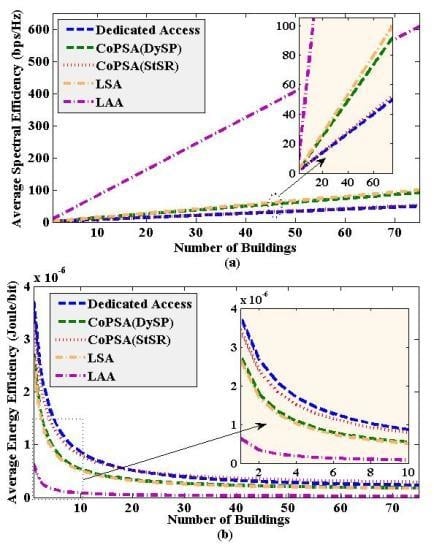Realization of Licensed/Unlicensed Spectrum Sharing Using eICIC in Indoor Small Cells for High Spectral and Energy Efficiencies of 5G Networks
Abstract
:1. Introduction
1.1. Background
1.2. Related Work
1.3. Problem Statement and Contribution
- Dual-band enabled SBSs,
- A set of small cell deployed 3D buildings, and
- TD ABS based eICIC technique.
1.4. Organization
1.5. Declaration
2. System Architecture, Spectrum Sharing Technique, and Interference Management
2.1. System Architecture
2.2. Dedicated Access
2.3. Co-primary Shared Access
2.3.1. Dynamic Spectrum Sharing by Pooling
2.3.2. Static Spectrum Sharing by Renting
- The strategy can help generate some revenues for MNO 2.
- No coordination between networks of MNOs 1 and 2 is needed.
- Unlike dynamic spectrum sharing, no CoRS is needed for real-time update and allocation of spectrum to the UEs of both MNOs.
- No spectrum is wasted because of the coordination control signaling exchanging over the backhaul between MNOs’ networks.
- Less complex and cost-effective solution in realization and maintenance as compared to the dynamic spectrum sharing since there is no cost associated with the CoRS implementation.
- No need for the interference management for static sharing since small cell UEs of MNO 1 and UEs of MNO 2 operate at the orthogonal spectrum of MNO 2.
2.4. Licensed Shared Access
- Multiband enabled SBSs serve small cell UEs at the satellite spectrum as follows. If a satellite UE is present inside a building, during non-ABSs of an APP, small cell UEs can be served and during ABSs , satellite UEs can be served. However, if no satellite UE is present inside a building, in any TTI of an APP, small cell UEs can be served (Figure 5).
- Similarly, small cells UEs can be served by multiband enabled SBSs at the mobile spectrum as follows. At the presence of an indoor macro UE, during non-ABSs of an APP, small cell UEs can be served and during ABSs , indoor macro UEs can be served. In the absence of an indoor macro UE within a building, small cell UEs can be served at the mobile spectrum in any TTI of an APP (Figure 6).
2.5. Licensed Assisted Access
- Availability of a huge amount of unused spectrum (57 to 66 GHz) can address high network capacity,
- High attenuation (specifically, additional free-space losses of 27.96 and 21.58 dB, respectively, on top of what at 2.4 GHz and 5 GHz for the same distance [22]) and large in-building material absorption results in low co-channel interference from neighboring cells,
- Small wavelength resulting in low aperture areas and hence enabling an array of antennas to deploy in small spaces to support high antenna directivity, and
- Low level of multipath effect and hence high possibility of the existence of line-of-sight (LOS) components at 60 GHz band than that at 2.4 GHz and 5 GHz band
2.6. Algorithm
| Algorithm 1. Realized spectrum sharing techniques |
| 01: Input: MNO 1 spectrum, MNO 2 spectrum, satellite spectrum, |
| 60 GHz unlicensed spectrum, TAPP, L |
| 02: For Transceiver 1 |
| 03: For Dedicated Spectrum Access |
| 04: If an indoor macro UE exists within a building |
| 05: TTI→ABS |
| 06: MNO 1 spectrum → indoor macro UEs |
| 07: Elseif an indoor macro UE does not exist within a building |
| 08: TTI→non-ABS |
| 09: MNO 1 spectrum → Transceiver 1 of in-building SBSs |
| 10: End |
| 11: End |
| 12: For CoPSA||LSA||LAA |
| 13: Run lines 04-11 once for each technique, i.e., CoPSA, LSA, and LAA |
| 14: End |
| 15: End // End of Transceiver 1 |
| 16: For Transceiver 2 |
| 17: If CoPSA |
| 18: Spectrum of MNO 2 → Transceiver 2 of small cells |
| 19: If Dynamic spectrum sharing by pooling (DySP) |
| 20: Allocate the outdoor UEs of MNO 1 to anywhere over the whole spectrum of MNO 1 |
| 21: Allocate the outdoor UEs of MNO 2 to anywhere over the whole spectrum of MNO 2 |
| 22: If TTI==ABS |
| 23: Allocate the spectrum of MNO 2 to UEs of MNO 2 within each 3D building |
| 24: Elseif TTI==non-ABS |
| 25: Allocate the spectrum of MNO 2 to small cell UEs of MNO 1 within each 3D building |
| 26: End |
| 27: Elseif Static spectrum sharing by renting (StSR) |
| 28: Allocate the outdoor UEs of MNO 1 to anywhere over the whole spectrum of MNO 1 |
| 29: If a UE of MNO 2 exists within a 3D building |
| 30: Allocate rented shared spectrum of MNO 2 to small cell UEs of MNO 1 |
| within each 3D building |
| 31: Allocate the UE of MNO 2 to the rest of the spectrum of MNO 2 orthogonal |
| to the rented shared spectrum for MNO 1 within each 3D Building |
| 32: Elseif a UE of MNO 2 exists outside of any 3D building |
| 33: Allocate the UE of MNO 2 to anywhere over the whole spectrum of MNO 2 |
| 34: End |
| 35: End |
| 36: Elseif LSA |
| 37: Spectrum of a Satellite System → Transceiver 2 of small cells |
| 38: If TTI==ABS |
| 39: Allocate the spectrum of a satellite system to satellite UEs within each 3D building |
| 40: Elseif TTI==non-ABS |
| 41: Allocate the spectrum of a satellite system to small cell UEs of MNO 1 |
| within each 3D building |
| 42: End |
| 43: Elseif LAA |
| 44: 60 GHz Unlicensed Spectrum→ Transceiver 2 of small cells |
| 45: Allocate the 60 GHz Unlicensed Spectrum to small cell UEs of MNO 1 |
| within each 3D building |
| 46: End |
| 47: End // End of Transceiver 2 |
| 48: Estimate and Output: Aggregate capacity, spectral efficiency, energy efficiency |
| of UEs of MNO 1 for multiband enabled small cells |
3. Problem Formulation
3.1. Preliminaries
3.2. Dedicated Access
3.3. Co-primary Shared Access
3.3.1. Dynamic Spectrum Pooling Technique
3.3.2. Static Spectrum Renting Technique
3.4. Licensed Shared Access
3.5. Unlicensed Shared Access
4. Optimal Number of ABSs and Default Parameters and Assumptions
4.1. Optimal Number of ABSs Estimation
4.2. Default System Parameters and Assumptions
5. Performance Evaluation and Comparison
5.1. Performance Evaluation
5.2. Optimal Value of L and Performance Comparison with 5G Mobile Network Requirements
6. Conclusions
Funding
Acknowledgments
Conflicts of Interest
References
- Li, F.; Lam, K.; Li, X.; Liu, X.; Wang, L.; Leung, V.C.M. Dynamic spectrum access networks with heterogeneous users: How to price the spectrum? IEEE Trans. Veh. Technol. 2018, 67, 5203–5216. [Google Scholar] [CrossRef]
- Garg, P.K.; Dua, T.R.; Chandra, A. Spectrum challenges for modern mobile services. J. ICT Standard. 2013, 1, 137–158. [Google Scholar] [CrossRef]
- Prasad, R. 5G: 2020 and Beyond; River Publishers: Aalborg, Denmark, 2014; p. 65. [Google Scholar]
- Song, Q.; You, M.; Lv, T. Incentives to spectrum trading. In Proceedings of the 2009 IEEE International Conference on Network Infrastructure and Digital Content, Beijing, China, 6–8 November 2009; pp. 948–952. [Google Scholar]
- Luoto, P.; Pirinen, P.; Bennis, M.; Samarakoon, S.; Scott, S.; Latva-aho, M. Co-primary multi-operator resource sharing for small cell network. IEEE Trans. Wirel. Commun. 2015, 14, 3120–3130. [Google Scholar] [CrossRef]
- Tehrani, R.H.; Vahid, S.; Triantafyllopoulou, D.; Lee, H.; Moessner, K. Licensed spectrum sharing schemes for mobile operators: A survey and outlook. IEEE Commun. Surv. Tutor. 2016, 18, 2591–2623. [Google Scholar] [CrossRef]
- Singh, B.; Hailu, S.; Koufos, K.; Dowhusko, A.A.; Tirkkonen, O.; Jäntti, R.; Berry, R. Coordination protocol for inter-operator spectrum sharing in co-primary 5G small cell networks. IEEE Commun. Mag. 2015, 53, 34–40. [Google Scholar] [CrossRef] [Green Version]
- Hailu, S.; Dowhuszko, A.A.; Tirkkonen, O. Adaptive co-primary shared access between co-located radio access networks. In Proceedings of the 2014 9th International Conference on Cognitive Radio Oriented Wireless Networks and Communications (CROWNCOM), Oulu, Finland, 2–4 June 2014; pp. 131–135. [Google Scholar]
- Teng, Y.; Wang, Y.; Horneman, K. Co-primary spectrum sharing for denser networks in local area. In Proceedings of the 2014 9th International Conference on Cognitive Radio Oriented Wireless Networks and Communications (CROWNCOM), Oulu, Finland, 2–4 June 2014; pp. 120–124. [Google Scholar]
- Mueck, M.D.; Srikanteswara, S.; Badic, B. Spectrum Sharing: Licensed Shared Access (LSA) and Spectrum Access Systems (SAS); Intel, Version 1.0, White Paper; Intel Corporation: Santa Clara, CA, USA, October 2015. [Google Scholar]
- Kang, D.H. Interference Coordination for Low-Cost Indoor Wireless Systems in Shared Spectrum. Ph.D. Thesis, KTH, Stockholm, Sweden, May 2014. [Google Scholar]
- Khawar, A.; Ahmad, I.; Sulyman, A.I. Spectrum sharing between small cells and satellites: Opportunities and challenges. In Proceedings of the 2015 IEEE International Conference on Communication Workshop (ICCW), London, UK, 8–12 June 2015; pp. 1600–1605. [Google Scholar]
- Saha, R.K. Spectrum sharing in satellite-mobile multisystem using 3D in-building small cells for high spectral and energy efficiencies in 5G and beyond era. IEEE Access 2019, 7, 43846–43868. [Google Scholar] [CrossRef]
- 3GPP. Study on New (NR) to Support non Terrestrial Networks (Release 15), Document 3GPP TR 38.811; 3rd Generation Partnership Project: Valbonne, France, June 2018. [Google Scholar]
- Guidotti, A.; Vanelli-Coralli, A.; Conti, M.; Andrenacci, S.; Chatzinotas, S.; Maturo, N.; Evans, B.; Awoseyila, A.; Ugolini, A.; Foggi, T.; et al. Architectures and key technical challenges for 5G systems incorporating satellites. IEEE Trans. Veh. Technol. 2019, 68, 2624–2639. [Google Scholar] [CrossRef]
- FCC. News 202/418-0500. 12 December 2012. Available online: https://www.fcc.gov/document/fcc-proposes-innovative-small-cell-use-35-ghzband (accessed on 29 October 2018).
- Almeida, E.; Cavalcante, A.M.; Paiva, R.C.D.; Chaves, F.S.; Abinader, F.M.; Vieira, R.D.; Choudhury, S.; Tuomaala, E.; Doppler, K. Enabling LTE/WiFi coexistence by LTE blank subframe allocation. In Proceedings of the 2013 IEEE International Conference on Communications (ICC), Budapest, Hungary, 9–13 June 2013; pp. 5083–5088. [Google Scholar]
- Zhang, H.; Chu, X.; Guo, W.; Wang, S. Coexistence of Wi-Fi and heterogeneous small cell networks sharing unlicensed spectrum. IEEE Commun. Mag. 2015, 53, 158–164. [Google Scholar] [CrossRef] [Green Version]
- Bhattarai, S.; Park, J.J.; Gao, B.; Bian, K.; Lehr, W. An overview of dynamic spectrum sharing: Ongoing initiatives, challenges, and a roadmap for future research. IEEE Trans. Cogn. Commun. Netw. 2016, 2, 110–128. [Google Scholar] [CrossRef]
- Salami, G.; Durowoju, O.; Attar, A.; Holland, O.; Tafazolli, R.; Aghvami, H. A Comparison between the centralized and distributed approaches for spectrum management. IEEE Commun. Surv. Tutor. 2011, 13, 274–290. [Google Scholar] [CrossRef]
- Saha, R.K. Inter-operator licensed spectrum sharing techniques for indoor small cells in 5G networks. In Proceedings of the IEEE GLOBECOM 2019 Workshop on Advancement in Spectrum Sharing, Waikoloa, HI, USA, 9–13 December 2019. [Google Scholar]
- Yilmaz, T.; Fadel, E.; Akan, O.B. Employing 60 GHz ISM band for 5G wireless communications. In Proceedings of the 2014 IEEE International Black Sea Conference on Communications and Networking (BlackSeaCom), Odessa, Ukraine, 27–30 May 2014; pp. 77–82. [Google Scholar]
- Saha, R.K.; Aswakul, C. A novel frequency reuse technique for in-building small cells in dense heterogeneous networks. IEEJ Trans. Electr. Electron. Eng. 2018, 13, 98–111. [Google Scholar] [CrossRef]
- Mustafa, H.A.U.; Imran, M.A.; Shakir, M.Z.; Imran, A.; Tafazolli, R. Separation framework: An enabler for cooperative and D2D communication for future 5G networks. IEEE Commun. Surv. Tutor. 2016, 18, 419–445. [Google Scholar] [CrossRef]
- Cui, Q.; Song, H.; Wang, H.; Valkama, M.; Dowhuszko, A.A. Capacity analysis of joint transmission CoMP with adaptive modulation. IEEE Trans. Veh. Technol. 2017, 66, 1876–1881. [Google Scholar] [CrossRef]
- Saha, R.K. A hybrid system and technique for sharing multiple spectrums of satellite plus mobile systems with indoor small cells in 5G and beyond era. IEEE Access 2019, 7, 77569–77596. [Google Scholar] [CrossRef]
- 3GPP. E-UTRA; Radio Frequency (RF) System Scenarios, Document 3GPP TR 36.942, V.1.2.0; 3rd Generation Partnership Project: Valbonne, France, July 2007. [Google Scholar]
- 3GPP. Simulation Assumptions and Parameters for FDD HeNB RF Requirements, Document TSG RAN WG4 (Radio) Meeting #51, R4-092042; 3rd Generation Partnership Project: Valbonne, France, May 2009. [Google Scholar]
- Geng, S.; Kivinen, J.; Zhao, X.; Vainikainen, P. Millimeter-wave propagation channel characterization for short-range wireless communications. IEEE Trans. Veh. Technol. 2009, 58, 3–13. [Google Scholar] [CrossRef]
- Saha, R.K.; Saengudomlert, P.; Aswakul, C. Evolution toward 5G mobile networks—A survey on enabling technologies. Eng. J. 2016, 20, 87–119. [Google Scholar] [CrossRef]
- Saha, R.K.; Aswakul, C. Incentive and architecture of multi-band enabled small cell and UE for up-/down-link and control-/user-plane splitting for 5G mobile networks. Freq. J. RF-Eng. Telecommun. 2017, 71, 95–118. [Google Scholar] [CrossRef]
- Wang, C.-X.; Haider, F.; Gao, X.; You, X.-H.; Yang, Y.; Yuan, D.; Aggoune, H.M.; Haas, H.; Fletcher, S.; Hepsaydir, E. Cellular architecture and key technologies for 5G wireless communication networks. IEEE Commun. Mag. 2014, 52, 122–130. [Google Scholar] [CrossRef]
- Auer, G.; Giannini, V.; Gódor, I.; Blume, O.; Fehske, A.; Rubio, J.A.; Frenger, P.; Olsson, M.; Sabella, D.; Gonzalez, M.J.; et al. How much energy is needed to run a wireless network? In Green Radio Communication Networks; Cambridge University Press: Cambridge, UK, 2012; Chapter 1; p. 20. [Google Scholar]
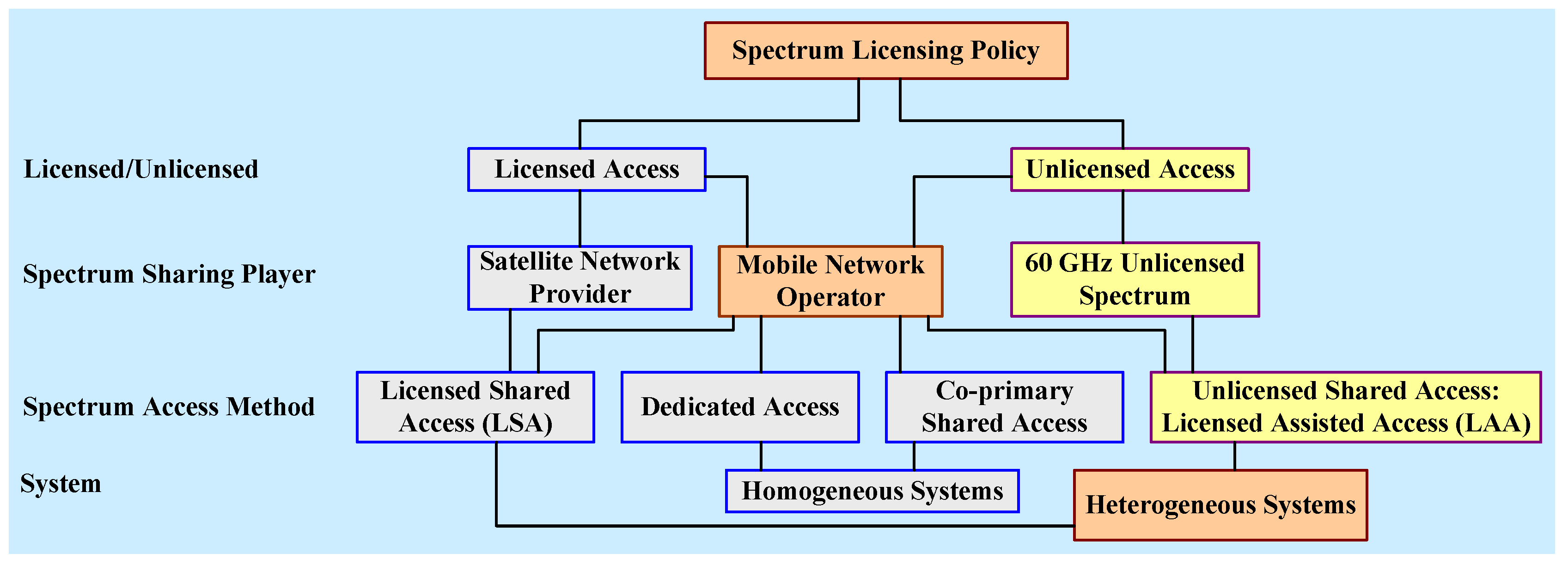


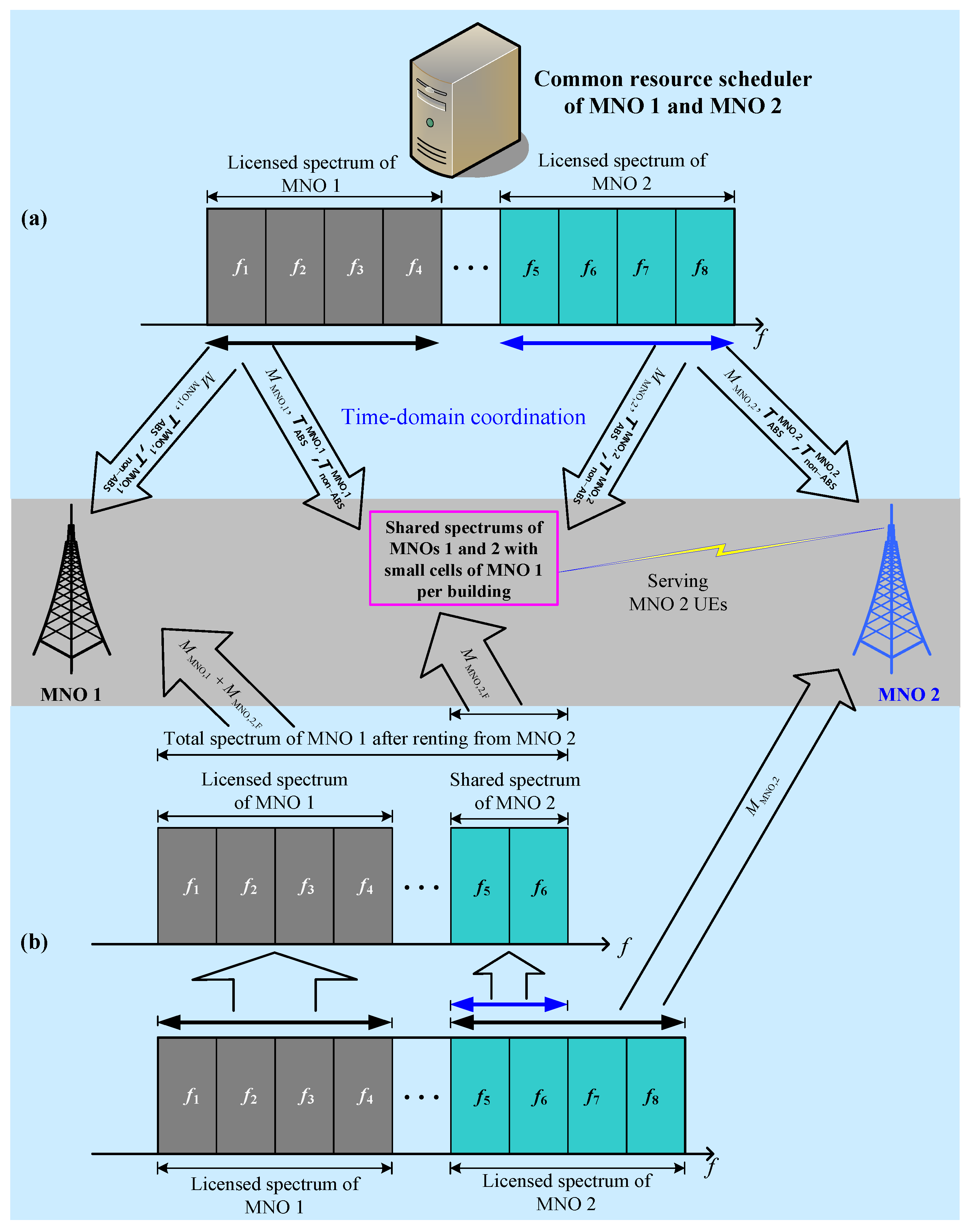
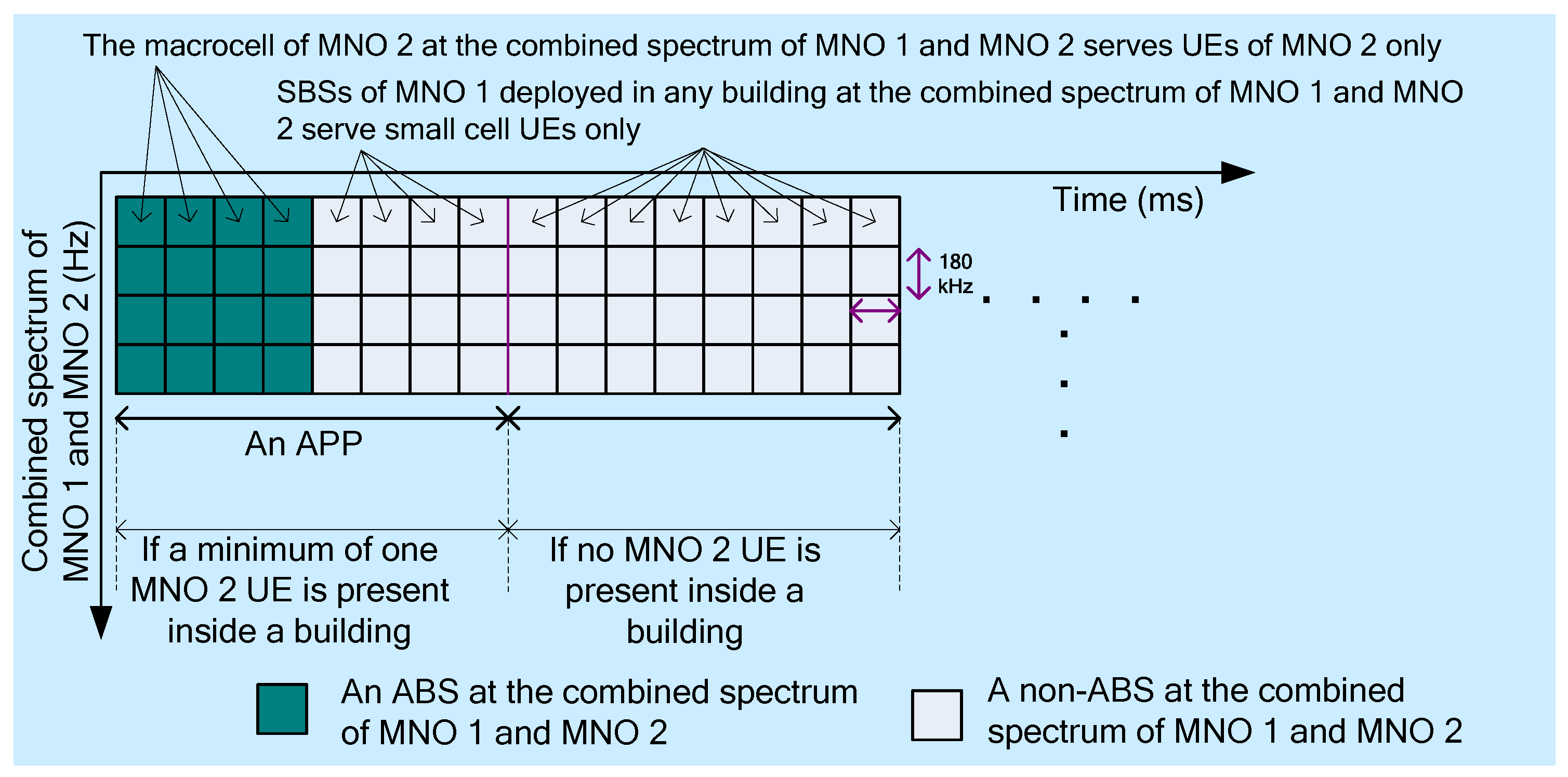
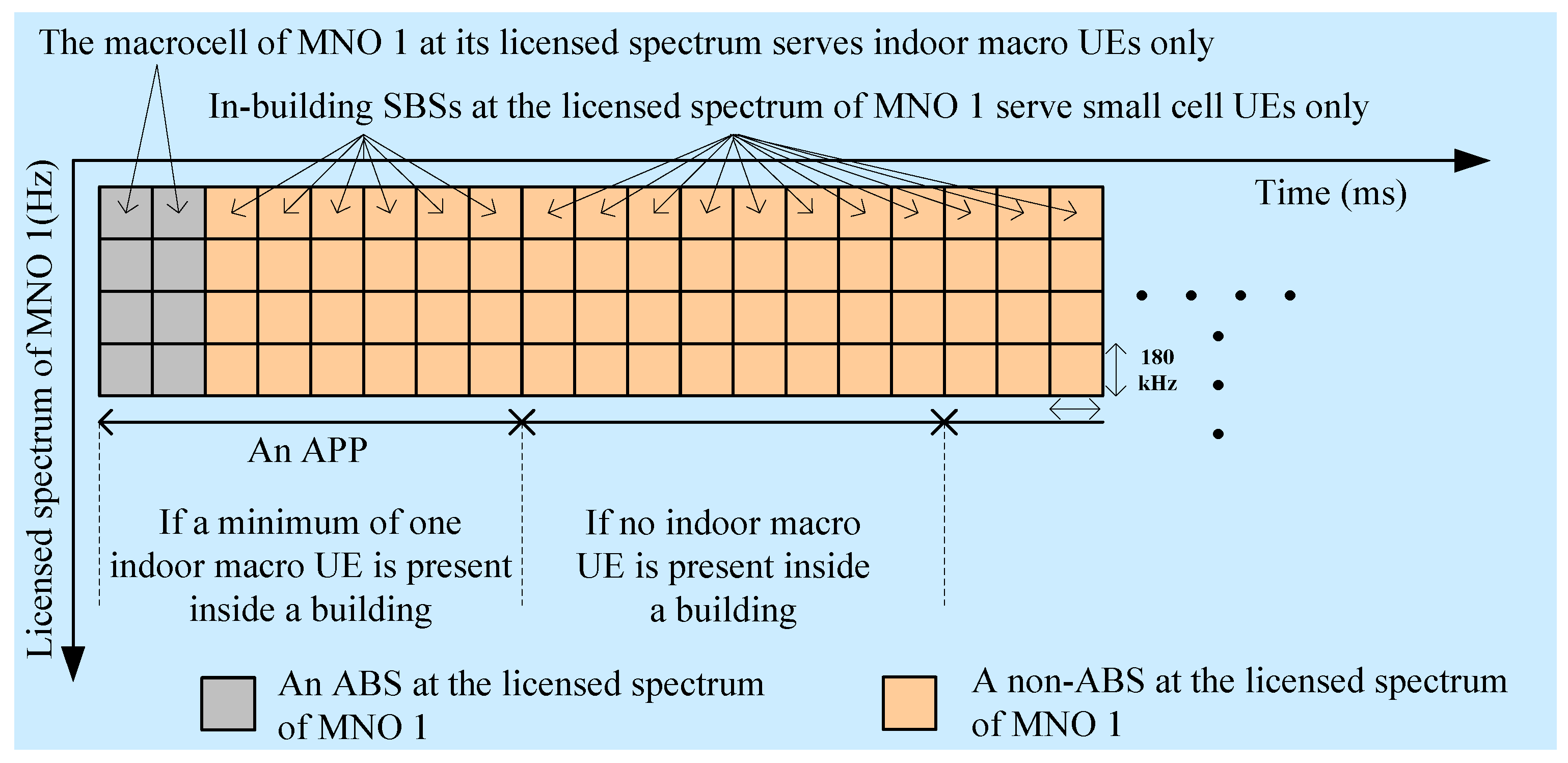
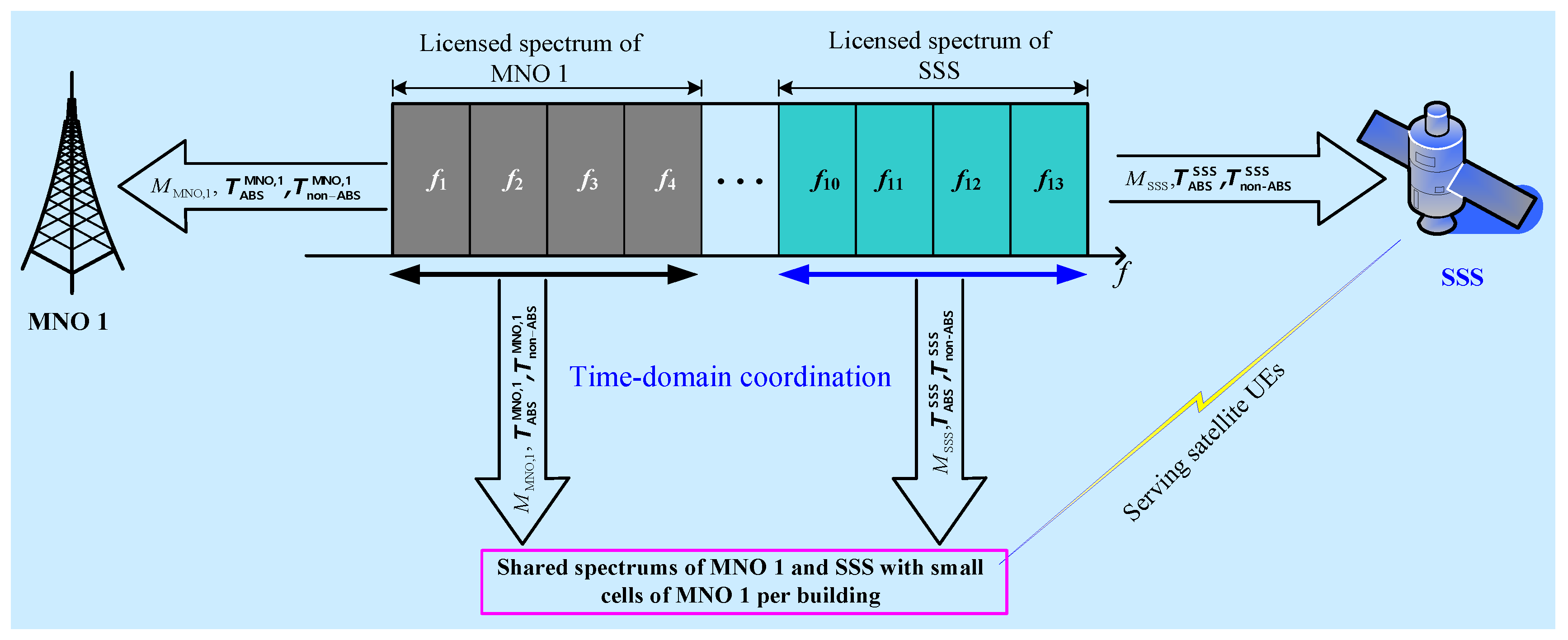
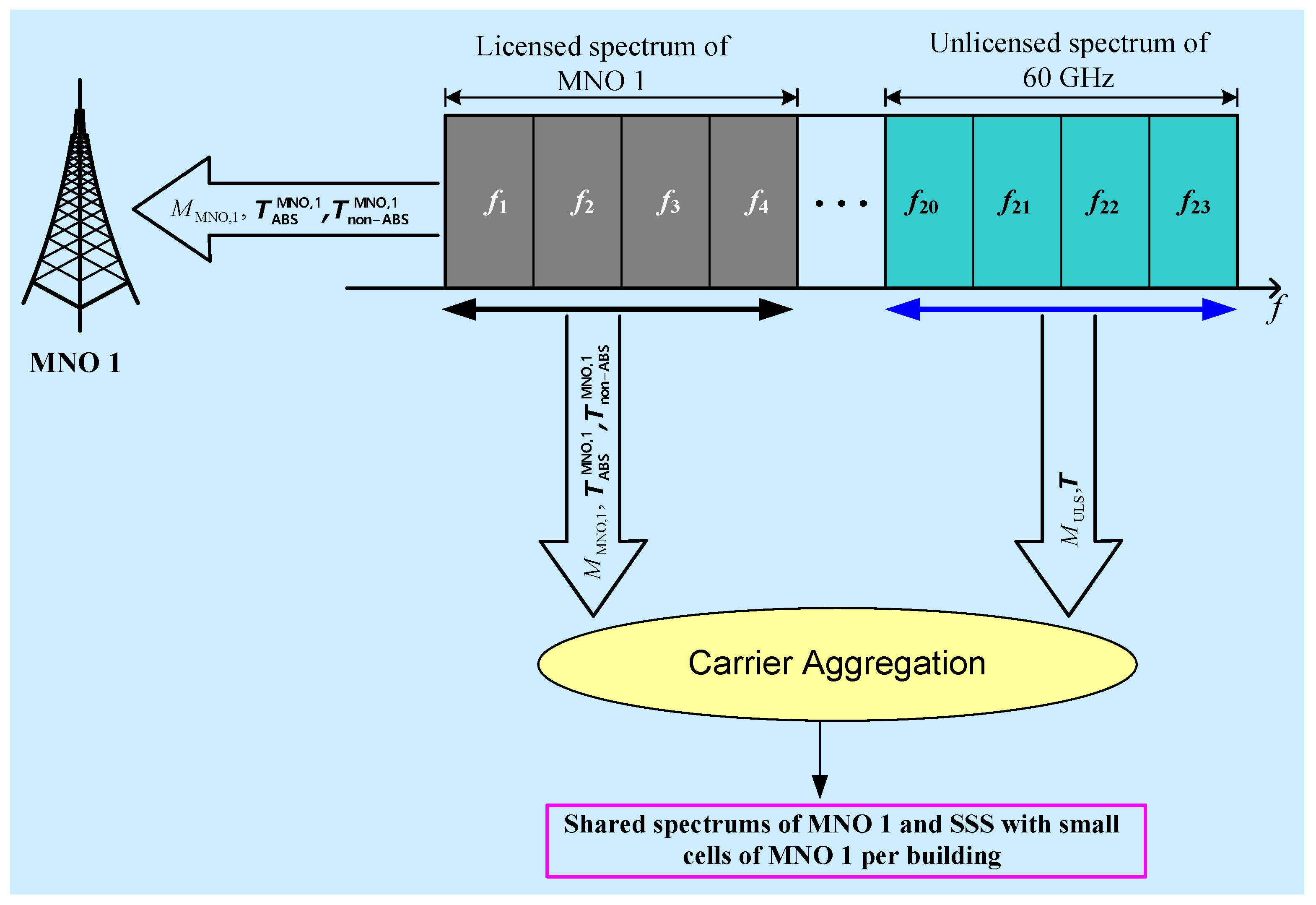
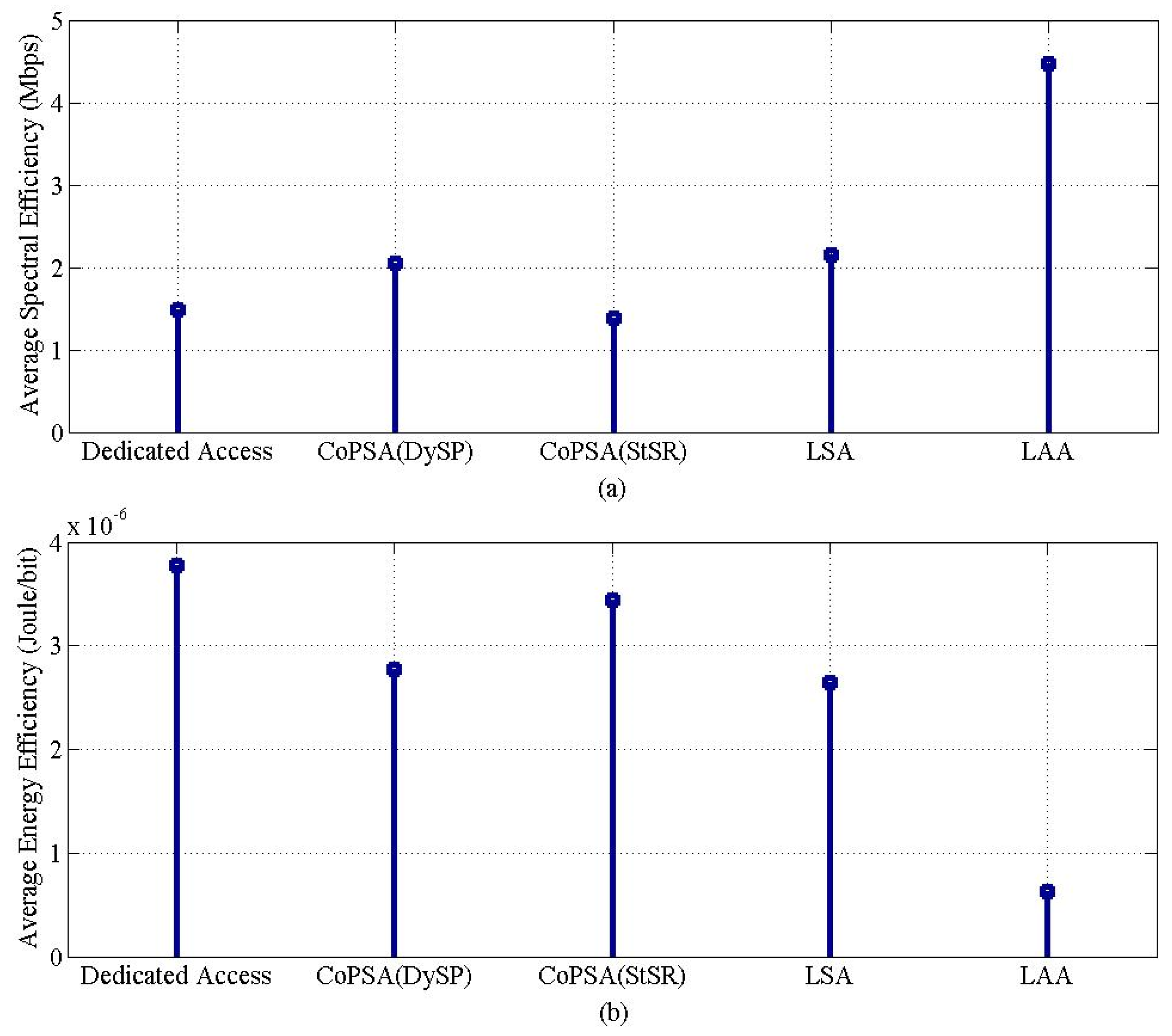

| Abbreviation | Explanation |
|---|---|
| 3D | 3-Dimensional |
| 3GPP | Third Generation Partnership Project |
| 5G | Fifth Generation |
| ABS | Almost Blank Subframe |
| APP | ABS Pattern Period |
| ASA | Authorized Shared Access |
| BS | Base Station |
| CA | Carrier Aggregation |
| CoPSA | Co-Primary Shared Access |
| CoRS | Common Resource Scheduler |
| CSI | Channel State Information |
| DedA | Dedicated Access |
| DySP | Dynamic Spectrum Sharing by Pooling |
| EE | Energy Efficiency |
| eICIC | Enhanced Inter-Cell Interference Coordination |
| FCC | Federal Communications Commission |
| FD | Frequency-Domain |
| ICIC | Inter-Cell Interference Coordination |
| ISD | Inter-Site Distance |
| ISD | Inter-site distance |
| ISM | Industrial, Scientific, and Medical |
| J/b | Joules/Bit |
| LAA | Licensed Assisted Access |
| LBT | Listen-Before-Talk |
| LOS | Line-of-Sight |
| LSA | Licensed Shared Access |
| LTE | Long-Term Evolution |
| MBS | Macrocell Base station |
| MNO | Mobile Network Operator |
| NRA | National Regulatory Agency |
| PBS | Picocell Base Station |
| PF | Proportional Fair |
| QoS | Quality-of-Service |
| RB | Resource Block |
| SBS | Small Cell Base Station |
| SE | Spectral Efficiency |
| SPS | Space Satellite System |
| StSR | Static Spectrum Sharing by Renting |
| TD | Time-Domain |
| TTI | Transmission Time Interval |
| UE | User Equipment |
| ULS | Unlicensed Spectrum |
| Notation | Definition |
|---|---|
| The aggregate capacity of all N macro UEs for RBs, Q TTIs, and L = 1 | |
| The system-level capacity of MNO 1 for the dedicated access technique | |
| N | Number of macro UEs of MNO 1 |
| ABS pattern | |
| T | Simulation run time |
| Q | Maximum number of TTIs in T each lasting 1 ms |
| TABS | A set of ABSs in T |
| t and i | Index of TTIs and RBs respectively |
| Signal-to-interference-plus-noise ratio at RB = i in TTI = t | |
| Link loss at RB = i in TTI = t | |
| Link throughput at RB = i in TTI = t | |
| Number of RBs in the MNO 1 spectrum | |
| Number of RBs in the MNO 2 spectrum | |
| Total spectrum due to the spectrum pooling at CoRS | |
| Number of RBs of MNO 2 that is rented to MNO 1 | |
| Number of RBs in the 60 GHz unlicensed spectrum | |
| Number of RBs in SPS spectrum | |
| SF | Number of small cells per building |
| SP | Number of picocells per macrocell |
| SM | Number of macrocells in the system |
| PPC | Transmit power of a picocell |
| PMC | Transmit power of a macrocell |
| PSC,1 | Transmit power of transceiver 1 of an SBS |
| PSC,2 | Transmit power of transceiver 2 of an SBS |
| A set of ABSs in the satellite spectrum | |
| A set of ABSs in the MNO 1 spectrum | |
| A set of non-ABSs in the MNO 1 spectrum | |
| A set of ABSs in the MNO 2 spectrum | |
| A set of non-ABSs in the satellite spectrum | |
| A set of non-ABSs in the satellite spectrum | |
| L | Total number of buildings per macrocell |
| The average rate of arrival of small cell UEs of MNO 1 into a building | |
| The average rate of arrival of UEs of MNO 2 into a building | |
| The average rate of arrival of satellite UEs of SPS into a building | |
| The average rate of arrival of indoor macro UEs of MNO 1 into a building | |
| The value of TAPP for the dedicated access technique | |
| The value of TAPP for the DySP technique | |
| The value of TAPP for the LSA technique | |
| Low | External wall penetration loss |
| Spectral efficiency for any value of | |
| Energy efficiency for any value of | |
| The minimum spectral efficiency requirement for 5G mobile systems | |
| The minimum energy efficiency requirement for 5G mobile systems | |
| An optimal value of L |
| Parameters and Assumptions | Value | |||||||||
|---|---|---|---|---|---|---|---|---|---|---|
| E-UTRA simulation case1 | 3GPP case 3 | |||||||||
| Cellular layout 2 and Inter-site distance (ISD) 1,2,5 | Hexagonal grid, dense urban, 3 sectors per macrocell site and 1732 m | |||||||||
| Carrier frequency 2,3 and transmit direction | 2 GHz (microwave), 60 GHz (millimeter wave line-of-sight), and downlink | |||||||||
| System bandwidth | 10 MHz downlink (for both 2 GHz and 60 GHz) | |||||||||
| Number of cells | 1 macrocell, 2 picocells, 8 SBSs per building for MNO 1 | |||||||||
| Total BS transmit power 1 (dBm) | 46 for microcell 1,4, 37 for picocell1, 20 (for 2 GHz) and 17.3 (for 60 GHz) for femtocell 1,3,4 | |||||||||
| Co-channel fading model 1 | Frequency selective Rayleigh for the macrocell and picocells, and Rician for SBSs (for 2 GHz) | |||||||||
| External wall penetration loss 1 (Low) | 20 dB | |||||||||
| Path loss | MBS and a UE 1,5 | Indoor macro UE | PL(dB) = 15.3 + 37.6log10R, R is in m | |||||||
| Outdoor macro UE | PL(dB) = 15.3 + 37.6log10R + Low, R is in m | |||||||||
| PBS and a UE 1 | PL(dB) = 140.7 + 36.7log10R, R is in km | |||||||||
| SBS and a UE 1,2,3,6 | PL(dB) = 127 + 30log10(R/1000), R in m (for 2 GHz), PL(dB) = 68 + 21.7log10(R), R in m (for 60 GHz) | |||||||||
| Lognormal shadowing standard deviation (dB) | 8 for MBS 2, 10 for PBS 1, and 10 (for 2 GHz) and 0.88 (for 60 GHz) for FCBS 2,3,6 | |||||||||
| Antenna configuration | Single-input single-output for all terrestrial mobile BSs and UEs | |||||||||
| Antenna pattern (horizontal) | Directional (1200) for microcell 1, omnidirectional for picocell 1 and SBS 1 | |||||||||
| Antenna gain plus connector loss (dBi) | 14 for MCBS 2, 5 for PCBS 1, 5 (for 2 GHz) and 5 (for 60 GHz, Biconical horn) for FCBS 1,3,6 | |||||||||
| UE antenna gain 2,3 | 0 dBi (for 2 GHz), 5 dBi (for 60 GHz, Biconical horn) | |||||||||
| UE noise figure 2 and UE speed 1 | 9 dB, 3 km/hr | |||||||||
| Total number of macro UEs for MNO 1 and Indoor macro UEs 1 | 30 and 35% | |||||||||
| Picocell coverage and macro UEs offloaded to all picocells 1 | 40 m (radius), 2/15 | |||||||||
| 3D multi-storage building, and SBS models (regular square-grid) | Number of buildings | L | ||||||||
| Number of floors per building | 2 | |||||||||
| Number of apartments per floor | 4 | |||||||||
| Number of SBSs per apartment | 1 | |||||||||
| SBS activation ratio | 100% | |||||||||
| SBS deployment ratio | 1 | |||||||||
| Total number of SBSs per building | 8 | |||||||||
| Area of an apartment | 10 × 10 m2 | |||||||||
| Location of an SBS in an apartment | center | |||||||||
| Scheduler and traffic model 2,5 | Proportional Fair (PF) and full buffer | |||||||||
| Type of SBSs 5 | Closed Subscriber Group femtocell BSs | |||||||||
| , , , | 8/8, 2/8, 4/8, 2/8 | |||||||||
| 8 ms, 8 ms, and 8 ms | ||||||||||
| Channel State Information (CSI) | Ideal | |||||||||
| TTI1, and scheduler time constant (tc) | 1 ms and 100 ms | |||||||||
| Total simulation run time | 8 ms | |||||||||
| Spectrum Sharing Technique (SS) | L (To Meet the 5G Mobile System Requirements) | ||
|---|---|---|---|
| Spectral Efficiency (bps/Hz/cell) | Energy Efficiency (μJ/b) | Both Spectral and Energy Efficiencies () | |
| Dedicated access | 56 | 2 | 56 |
| CoPSA (DySP) | 30 | 1 | 30 |
| CoPSA (StSR) | 54 | 2 | 54 |
| LSA | 28 | 1 | 28 |
| LAA | 5 | 1 | 5 |
© 2019 by the author. Licensee MDPI, Basel, Switzerland. This article is an open access article distributed under the terms and conditions of the Creative Commons Attribution (CC BY) license (http://creativecommons.org/licenses/by/4.0/).
Share and Cite
Saha, R.K. Realization of Licensed/Unlicensed Spectrum Sharing Using eICIC in Indoor Small Cells for High Spectral and Energy Efficiencies of 5G Networks. Energies 2019, 12, 2828. https://doi.org/10.3390/en12142828
Saha RK. Realization of Licensed/Unlicensed Spectrum Sharing Using eICIC in Indoor Small Cells for High Spectral and Energy Efficiencies of 5G Networks. Energies. 2019; 12(14):2828. https://doi.org/10.3390/en12142828
Chicago/Turabian StyleSaha, Rony Kumer. 2019. "Realization of Licensed/Unlicensed Spectrum Sharing Using eICIC in Indoor Small Cells for High Spectral and Energy Efficiencies of 5G Networks" Energies 12, no. 14: 2828. https://doi.org/10.3390/en12142828
APA StyleSaha, R. K. (2019). Realization of Licensed/Unlicensed Spectrum Sharing Using eICIC in Indoor Small Cells for High Spectral and Energy Efficiencies of 5G Networks. Energies, 12(14), 2828. https://doi.org/10.3390/en12142828




